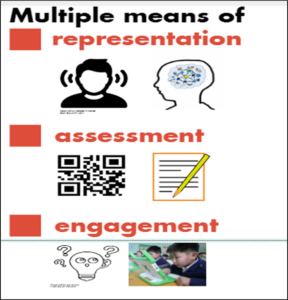The Universal Design for Learning (UDL) principles can help guide you in developing learning activities and assessments that meet the needs, interests, and experiences of all of your students. There are three main UDL Principles to keep in mind when designing your lesson plan: Multiple Means of Representation, Multiple Means of Action and Expression, and Multiple Means of Engagement.

Multiple Means of Representation
Provide a variety of ways for students to observe and perceive the content. For example, you can design activities that allow students to use multiple senses to explore the content (e.g., allow students to watch a flocabulary video, read step-by-step instructions, and/or use accessible math manipulatives to explore the concept of dividing fractions).
Multiple Means of Action and Expression
Design assessments that allow students to show their knowledge and skills in a variety of ways. For example, you can encourage students to create, perform, redesign, draw, teach, and innovate. Additionally, there are many free web-based, multimedia tools that students can use to demonstrate mastery of the content (e.g., video, podcast, animation, digital story, app, eBook, website). For more information, read: Why You Should Stop Testing and Start Assessing.
Multiple Means of Engagement
Find ways to pique the students’ interest in learning. (Don’t forget about the ARCS Model from Week 2!) There are many different variables that can shape students’ interests in learning (e.g., prior knowledge, experience, culture, language, career goals, learning goals). Therefore, your challenge is to design activities that motivate all learners to participate in the learning activities. One way to do this is to provide opportunities for students to choose what they want to learn and how they want to learn it.
In addition to motivating learners, you need to support the ongoing process of learning. This can be done by teaching students self-regulation skills and by providing feedback and showing students how to make use of the feedback to improve their learning.
UDL at a Glance
To learn more about UDL, watch the UDL at a Glance video or explore the UDL On Campus website.
